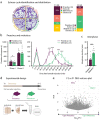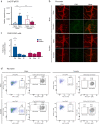Formalin-evoked pain triggers sex-specific behavior and spinal immune response
- PMID: 37308519
- PMCID: PMC10261048
- DOI: 10.1038/s41598-023-36245-7
Formalin-evoked pain triggers sex-specific behavior and spinal immune response
Abstract
Mounting evidence shows sex-related differences in the experience of pain with women suffering more from chronic pain than men. Yet, our understanding of the biological basis underlying those differences remains incomplete. Using an adapted model of formalin-induced chemical/inflammatory pain, we report here that in contrast to male mice, females distinctly display two types of nocifensive responses to formalin, distinguishable by the duration of the interphase. Females in proestrus and in metestrus exhibited respectively a short-lasting and a long-lasting interphase, underscoring the influence of the estrus cycle on the duration of the interphase, rather than the transcriptional content of the dorsal horn of the spinal cord (DHSC). Additionally, deep RNA-sequencing of DHSC showed that formalin-evoked pain was accompanied by a male-preponderant enrichment in genes associated with the immune modulation of pain, revealing an unanticipated contribution of neutrophils. Taking advantage of the male-enriched transcript encoding the neutrophil associated protein Lipocalin 2 (Lcn2) and using flow cytometry, we confirmed that formalin triggered the recruitment of LCN2-expressing neutrophils in the pia mater of spinal meninges, preferentially in males. Our data consolidate the contribution of female estrus cycle to pain perception and provide evidence supporting a sex-specific immune regulation of formalin-evoked pain.
© 2023. The Author(s).
Conflict of interest statement
The authors declare no competing interests.
Figures




References
Publication types
MeSH terms
Substances
LinkOut - more resources
Full Text Sources
Medical
Molecular Biology Databases
Miscellaneous

